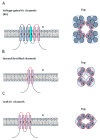Exploring the Therapeutic Potential of Membrane Transport Proteins: Focus on Cancer and Chemoresistance
- PMID: 32575381
- PMCID: PMC7353007
- DOI: 10.3390/cancers12061624
Exploring the Therapeutic Potential of Membrane Transport Proteins: Focus on Cancer and Chemoresistance
Abstract
Improving the therapeutic efficacy of conventional anticancer drugs represents the best hope for cancer treatment. However, the shortage of druggable targets and the increasing development of anticancer drug resistance remain significant problems. Recently, membrane transport proteins have emerged as novel therapeutic targets for cancer treatment. These proteins are essential for a plethora of cell functions ranging from cell homeostasis to clinical drug toxicity. Furthermore, their association with carcinogenesis and chemoresistance has opened new vistas for pharmacology-based cancer research. This review provides a comprehensive update of our current knowledge on the functional expression profile of membrane transport proteins in cancer and chemoresistant tumours that may form the basis for new cancer treatment strategies.
Keywords: cancers; chemoresistance; ion channels; membrane transporters; pumps.
Conflict of interest statement
The authors declare no conflict of interest.
Figures







References
-
- Yamashita N., Hamada H., Tsuruo T., Ogata E. Enhancement of voltage-gated Na+ channel current associated with multidrug resistance in human leukemia cells. Cancer Res. 1987;47:3736–3741. - PubMed
Publication types
Grants and funding
LinkOut - more resources
Full Text Sources
Other Literature Sources

